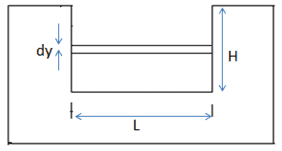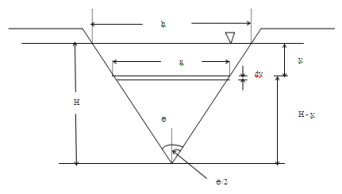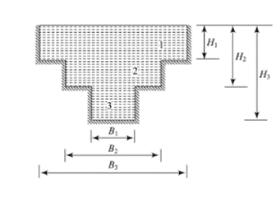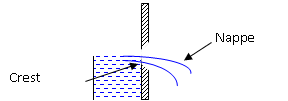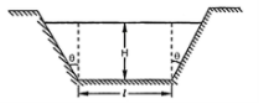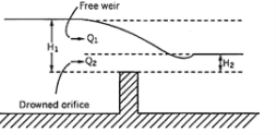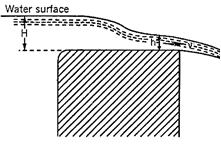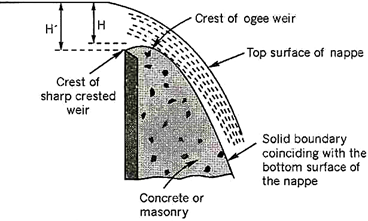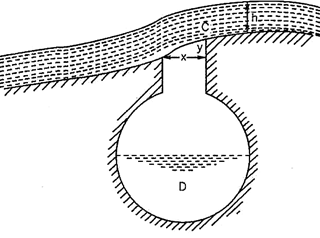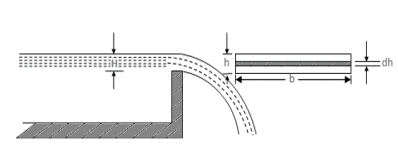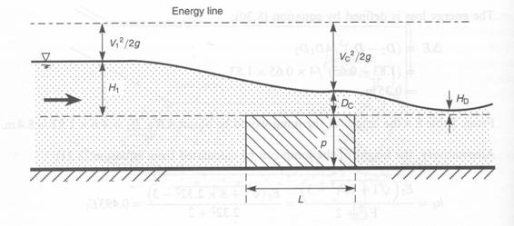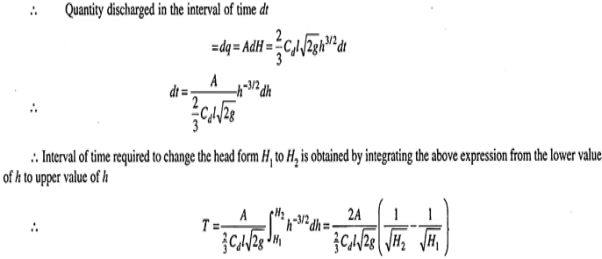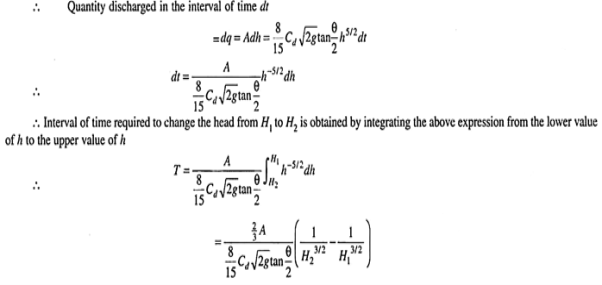A1)
A Notch is a device used for measuring the rate of flow of a liquid through a small channel or a tank. It may be defined as an opening in the side of a tank or vessel such as liquid surface in the tank is below the level of opening. Notches can be of different shapes such as a triangular, rectangular, trapezoidal, stepped notch, etc. the bottom of the notch over which the water flows is known as crest or sill and the thin sheet of water flowing through the notch is known as nappe or vein. The edges of the notch are bevelled on the downstream side to have a sharp-edged side and crest resulting in minimum contact with the flowing fluid.
The discharge over notch is measured by measuring the head acting over the notch. As water approaches the notch, its surface becomes curved. Therefore, the head over the notch is to be measured at the upstream of the notch where the effect of curvature is minimum. Also, it should be close to the notch so that the loss of energy between the head measuring section and notch is negligible. In practice, the head over notch is measured at a distance of 3 to 4 times the maximum head from the notch.
It takes its name from the shape of its notch. The discharge through a weir or notch is directly related to the water depth or head (H). This head is affected by the condition of the crest, the contraction, the velocity of the approaching stream, and the elevation of the water surface downstream from the weir.
Rectangular notch
2. Trapezoidal or Cipolletti notch: The Cipolletti notch is trapezoidal. The slope of the sides, inclined outwardly from the crest and should be one horizontal to four vertical.
Trapezoidal notch
3. V-Notch In this case, the notch is "V" in shape. The depth of water above the bottom of the V is called head (H). The V-notch design causes small changes in discharge hence causing a large change in depth and thus allowing more accurate measurement than with a rectangular notch.
V notch
4. Stepped notch: A stepped notch is a combination of rectangular notches as shown in figure 4-6. It is thus obvious that the discharge over such a notch will be the sum of the discharges over the different rectangular notches.
Stepped notch |
Q2) Describe weirs and their various types.
A2)
A weir is a small barrier built across a stream or river to raise the water level slightly on the upstream side; essentially a small-scale dam. Weirs allow water to pool behind them while allowing water to flow steadily over top of the weir. Additionally, the term weir can be used to refer to the crest of a spillway on a large embankment dam. Weirs can be constructed out of several different materials, depending on their age and purpose. Wood, concrete, or a mixture of rocks, gravel, and boulders can all be used to construct a weir. In a weir, the surface over which the water flows is known as the crest. The flow of water that moves over the top of this crest is known as the nappe, which is simply the water that makes it overtop the weir. This nappe does not exist with dams, as dams permit no flow of water over the structure. If this nappe falls a significant distance through the air - meaning that the weir increases the elevation of the water before the weir - the weir is said to have free discharge. However, if water flows partially underwater as a result of little elevation increase from the weir it is said to be submerged or drowned.
Weirs can be classified as follows: 1. Proportional Weir:This is a weir whose shape is so designed that the discharge over the weir is proportional to the head of water over the crest. The crest of the weir is horizontal.
Proportional weir
2. The Cippoletti Weir:A weir that is so compensated to make up for the loss of discharging capacity due to end contractions is called a Cippoletti weir.
Cippoletti weir
3. Submerged Weir:Fig. shows a submerged weir. In this case, the water level on the downstream side also is above the crest of the weir.
Submerged weir
4. Anicut or Raised Weir or Barrage:An anicut is a masonry dam provided across a river to raise the water level on the upstream side to a sufficient extent in the dry season so that the water can be carried by gravitation to places where it otherwise could not reach.
5. Broad Crested Weir:This is a weir having a very broad sill so that the flow of water over the sill may be compared to the flow of water in a channel. Consider the broad crested weir shown in Fig.
Broad crested weir
6. Ogee Weir:We know, in the case of a sharp-crested weir the nappe as it leaves the crest springs or rises slightly at the lower surface. In this way, it reaches a maximum rise of 0.115 H’ above the crest and then falls. (H’ is the head over the sharp crest). Suppose the space below the bottom surface of the nappe is filled with masonry or concrete. The consequent weir formed is shown in Fig. Such a weir is called an ogee weir. Thus in an ogee weir, the solid boundary of the weir exactly coincides with the bottom surface of the nappe of the sharp-crested weir under the designed head.
Ogee weir
7. Separating Weir:A separating weir is an arrangement provided in the case of town water supply, where it may become necessary to divert the discoloured floodwater from the supply channel. When the discharge is moderate, the water drops over the lip C into a culvert D which communicates with the supply channel. But during floods, the velocity of flow will be greater due to greater depth and this causes the water to leap across the opening into the waste channel.
Separating weir
|
Q3) Derive the discharge equation.
A3)
) Let us consider a horizontal strip of water of thickness dh at a depth of h from the water level as shown in figure
Let, H = Height of water above the sill of a notch b = Width or length of the notch Cd = Coefficient of discharge
The theoretical velocity of water through the strip
Discharge through the strip,
The total discharge over the whole notch may be found out by integrating the above equation within the limits 0 and H.
|
Q4) What is approach velocity?
A4)
T The velocity of the approach can be determined by dividing the discharge by the area of flow of water in the stream on the upstream side of the weir. We may first calculate the discharge ignoring the velocity of the approach. This approximate value of the discharge is divided by the area of the approach channel and an approximate value of the velocity of the approach is determined. The corresponding head due to the velocity of the approach is calculated. Now a more accurate value of the discharge is calculated from the above equation. This process may be repeated to get a more accurate value of the discharge. Consider a weir provided across a river. The water which is approaching the weir possesses a certain velocity known as the velocity of approach. The discharge over the weir is increased due to the velocity of the approach. Let va be the velocity of approach. This condition is equivalent to a condition in which the free water surface is static at a higher level, at a height ha = va2/2g. The head ha is called the head due to the velocity of approach. If the head of the actual flowing water level over the crest is H, the weir opening may be taken as equivalent to a large orifice in which the heads of still water above the top and bottom edges are respectively, ha and H + ha.
Accordingly, the discharge is given by, The quantity H + ha is called still water head |
.
Q5) Describe the procedure for calibration of notches.
A5) The pump sucks the water from the sump tank and discharges it to a small flow channel. The notch is fitted at the end of the channel. All the notches and weirs are interchangeable. The water flowing over the notch falls in the collector. Water coming from the collector is directed to the measuring tank for the measurement of flow.
The following procedure is followed for calibration:1. Fit the required notch in the flow channel.2. Fill up the water in the sump tank. 3. Open the water supply gate valve to the channel and fill up the water in the channel up to the skill level.4. Take down the initial reading of the crest level (sill level) 5. Now start the pump and open the gate valve slowly so that water starts flowing over the notch 6. Let the water level become stable and note down the height of the water surface at the upstream side by the sliding depth gauge. 7. Close the drain valve of the measuring tank, and measure the discharge. 8. Take the reading for different flow rates. 9. Repeat the same procedure for other notches also.Q6) What are the errors in the measurement of discharge?
A6) Whenever a flow rate or discharge is measured, the value obtained is simply the best estimate of the true flow rate which can be obtained from the data collected; the true flow rate may be slightly greater or less than this value. The usefulness of the flow rate measurement is greatly enhanced if a statement of possible error accompanies the result. The error may be defined as the difference between the true flow rate and the flow rate which is calculated from the measured water level (upstream head) with the aid of the appropriate head-discharge equations. It is not relevant to give an absolute upper bound to the value of error. Due to chance, such bounds can be exceeded. Taking this into account, it is better to give a range that is expected to cover the true value of the measured quantity with a high degree of probability. This range is termed the uncertainty of measurement, and the confidence level associated with it indicates the probability that the range quoted will include the true value of the quantity being measured Nature of errors Three types of error must be considered: a. Spurious errors (human mistakes and instrument malfunctions); b. Random errors (experimental and reading errors); c. Systematic errors (which may be either constant or variable). a. Spurious errors are errors that invalidate a measurement. Such errors cannot be incorporated into a statistical analysis with the object of estimating the overall accuracy of a measurement and the measurement must be discarded. Steps should be taken to avoid such errors or to recognize them and discard the results. Alternatively, corrections may be applied.b. Random errors are errors that affect the reproducibility of the measurement. It is assumed that data points deviate from the mean by the laws of chance as a result of random errors. The mean random error of a summarized discharge over a period is expected to decrease when the number of discharge measurements during the period increases. As a result, the integrated flow over a long period of observation will have a mean random error that approaches zero. It is emphasized that this refers to time-dependent errors only and that the length of time over which observations should be made has to be several times the period of fluctuations of flow. c. Systematic errors are errors that cannot be reduced by increasing the number of measurements so long as equipment and conditions remain unchanged. Whenever there is evidence of a systematic error of a known sign, the mean error should be added to (or subtracted from) the measurement results. A residual systematic error should be assessed as half the range of possible variation that is due to this systematic error. A strict separation of random and systematic errors has to be made because of their different sources and the different influence ‘they have on the total error. This influence will depend on whether the error in a single measurement is concerned, or that in the sum of a series of measurements.Q7) Write a description of the broad crested weir with the discharge equation.
A7)Broad crested weirs are robust structures that are generally constructed from reinforced concrete and which usually span the full width of the channel. They are used to measure the discharge of rivers and are much more suited for this purpose than the relatively flimsy sharp-crested weirs. Additionally, by being a critical depth meter, the broad crested weir has the advantage that it operates effectively with higher downstream water levels than a sharp-crested weir.
Head-discharge relationship A rectangular broad crested weir is shown above. When the length, L, of the crest is greater than about three times the upstream head, the weir is broad enough for the flow to pass through critical depth somewhere near its downstream edge. Consequently, this makes the calculation of the discharge relatively straightforward. Applying the continuity equation to the section on the weir crest where the flow is at critical depth gives: Q = Ac Vc. Now assuming that the breadth of the weir (b) spans the full width (B) of the channel and that the cross-sectional area of flow is rectangular, then: Ac = b x Dc and Vc = (g x Dc)1/2 Thus from the continuity equation, However, equation 1 does not provide a very practical means of calculating Q. It is much easier to use a stilling well located in a gauging hut just upstream of the weir to measure the head of water, H1, above the crest than to attempt to measure the critical depth on the crest itself. To eliminate Dc from the equation, we can use the fact that in a rectangular channel So, Thus, If you substitute this expression into Eqn 1, it gives: The term |
Q8) Derive the discharge coefficient equation for round crested weirs.
A8)The formulation for the discharge coefficient was derived from experimental data, which should be a function of the dimensionless parameters listed in the discharge equation given by:
According to experimental data distribution and Equation, the best fit function of the discharge coefficient was assumed to be of the following form: Cd = k1(h/P)k2 where k1 and k2 are parameters that are calculated by r/b. It can be seen that when r/b increases from 0.30 to 0.75, k1 increases, and k2 decreases. b is the half-width of the round weir, and the half-width of the weir near the downstream was not in contact with the flow and did not affect the nappe. The equations for k1 and k2 can be written as follows: k1 = f1(r/b) k2 = f2(r/b) Based on a multivariate optimization approach, the best-fit parameters can be derived by using five data sets of the present experiment in the range of a round-crested weir, and two calculated expressions can be obtained: k1 = 0.05 r/b + 0.645 k2 = −0.075 r/b + 0.0055 Incorporating the previous two equations into the flow rate equation, the formula for the discharge coefficient can be written as Cd = (0.05 r/b + 0.645) × (h/P) (−0.075 r/b +0.0055) where h = 0.05–0.20 m, and r/b = 0.30–0.75.
|
A9)
By a Rectangular Weir: Let a reservoir of plan area A be provided with a rectangular weir of length I. Let it be required to find the time taken for the head of water over the weir to fall from a value H1 to a value H2. Let at any instant the head of water over the weir be h. Let the fall in water level be dh in a small interval of time dt
Time of Emptying a Reservoir by a Triangular Notch:
Let a reservoir of plan area A be provided with a triangular notch of angle θ. Let it be required to find the time taken for the head of water over the notch to fall from a value H1 to a value H2. Let at any instant the head of water over the notch be h. Let the fall in water level be dh in a small interval of time dt.
|
Q10) Water flows through a contracted rectangular weir 120 cm long to a depth of 30 cm, it then flows along a rectangular channel 150 cm wide and over a second weir which has a length equal to the width of the channel. Determine the depth of water over the second weir.A10)
Solution: The first weir is contracted, i.e. both ends contracted. Given, Length of the weir (L) = 120 cm Depth of water over the weir (H) = 30 cm So, Discharge of flow = = 344.67 L/sec In the second weir, length of the weir (L) =150 cm Discharge through the first weir and second weir is the same. Let assume, depth of water over the second weir is = H cm Now,
H= 24.97 cm
|
Solution: Given, Crest width (L) = 60 cm Head of flow over the crest (H) = 30 cm So, discharge through the weir (Q) =
= 183.37 L/sec The discharge of the Cipoletti weir is 183.37 L/sec
|
